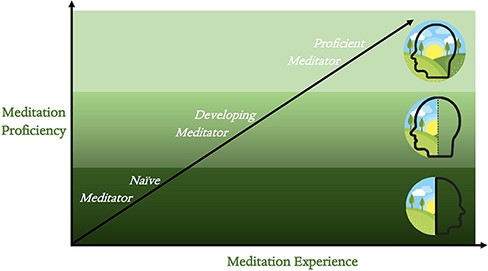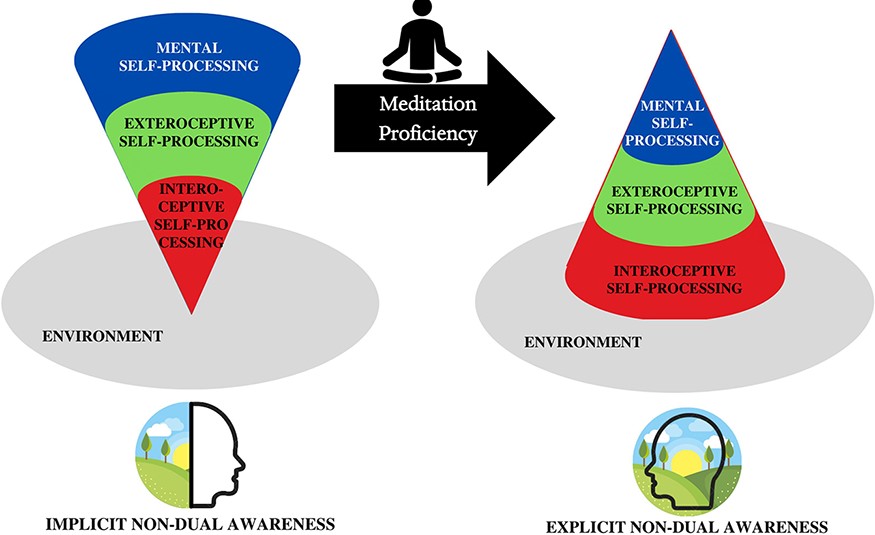I stated in a previous post the insight into our neurology of meditation, in order to attain our goal to keep it simple, but often fail to realize it. I already suggested, we need “to kill our darlings” in order to be open to the full context of the terrain we’re exposed to.
A recent paper from Cooper, Ventura, and Northoff “Beyond the veil of duality—topographic reorganization model of meditation” elaborates on this theme, and I like to refer to the summary:
Meditation can exert a profound impact on our mental life, with proficient practitioners often reporting an experience free of boundaries between a separate self and the environment, suggesting an explicit experience of “nondual awareness.”

Meditation proficiency and experience are understood as correlated, although, this relationship is definitely not as straightforward as displayed since different meditation practitioners with the same amount of experience do not necessarily have the same subjective states during rest and meditation
What are the neural correlates of such experiences and how do they relate to the idea of nondual awareness itself? In order to unravel the effects that meditation has on the brain’s spatial topography, we review functional magnetic resonance imaging brain findings from studies specific to an array of meditation types and meditator experience levels. We also review findings from studies that directly probe the interaction between meditation and the experience of the self.
The main results are
(i) decreased posterior default mode network (DMN) activity,
(ii) increased central executive network (CEN) activity,
(iii) decreased connectivity within posterior DMN as well as between posterior and anterior DMN,
(iv) increased connectivity within the anterior DMN and CEN, and
(v) significantly impacted connectivity between the DMN and CEN (likely a nonlinear phenomenon).

(A) The practicing meditator learns to maintain focused attention through CEN activation; although once a certain level of proficiency (a transformed default mode) is reached, there is no longer a need for extensive CEN activation, and there is an extended default mode in which DMN and CEN can be coactive. Coinciding with CEN activity is the connectivity between the DMN and CEN networks of the brain: effort is needed to suppress DMN hyperactivity and activate the CEN (negative connectivity/anticorrelation), which evolves to a coactivation (positive connectivity) of the two networks. This coactivation is affiliated with experience of explicit nondual awareness.
(B) The transition from dominant DMN, to dominant CEN, and finally to co-active DMN and CEN is affiliated with global connectivity changes. Primarily, the posterior DMN’s intra-connectivity is decreased, both anterior DMN’s and CEN’s intra-connectivity is increased, and the interconnectivity between the DMN and CEN is increased
Together, these suggest a profound organizational shift of the brain’s spatial topography in advanced meditators—we therefore propose a topographic reorganization model of meditation (TRoM). One core component of the TRoM is that the topographic reorganization of DMN and CEN is related to a decrease in the mental-self-processing along with a synchronization with the more nondual layers of self-processing, notably interoceptive and exteroceptive-self-processing.
This reorganization of the functionality of both brain and self-processing can result in the explicit experience of nondual awareness.

In conclusion, this review provides insight into the profound neural effects of advanced meditation and proposes a result-driven unifying model (TRoM) aimed at identifying the inextricably tied objective (neural) and subjective (experiential) effects of meditation.
The conclusion of the paper is:
Proficient meditation unravels a deeper social and ecological intero-exteroceptive layer of self where it is intimately connected with the environment in a nondual manner.
This hints upon a more basic and fundamental notion of self where it is determined by and through its relationship to the other/environment.
Reaching beyond the duality of self-other/environment, this deeper relational layer of self is intrinsically neuro-ecological and neuro-social.
That connects this deeper layer of self intimately with both other and world in a positive way, that is, integrated and rather than segregated.
Proficient meditation can thus provide us with a deeper level in our experience of the own self, a nondual experience where our self is integrated with the other and part of the wider world, as discussed in previous neurophenomenological models of explicit nondual awareness.
This allows to lay bare a deeper ecological and social nondual layer not only of ourself but, correspondingly, also of our brain featured by its deeper most basic and fundamental nondual spatial topography serving as its default or baseline.

One response to ““decrease the mental-self-processing & a synchronization with the interoceptive and exteroceptive-self-processing”.”
[…] deze regels te realiseren, moet soms overgaan tot “kill your darlings”Dit ondergeschikt maken van het eigen model over hoe het “zou moeten zijn”, en bereidheid om de context (het verhaal, het terrein) te […]
LikeLike